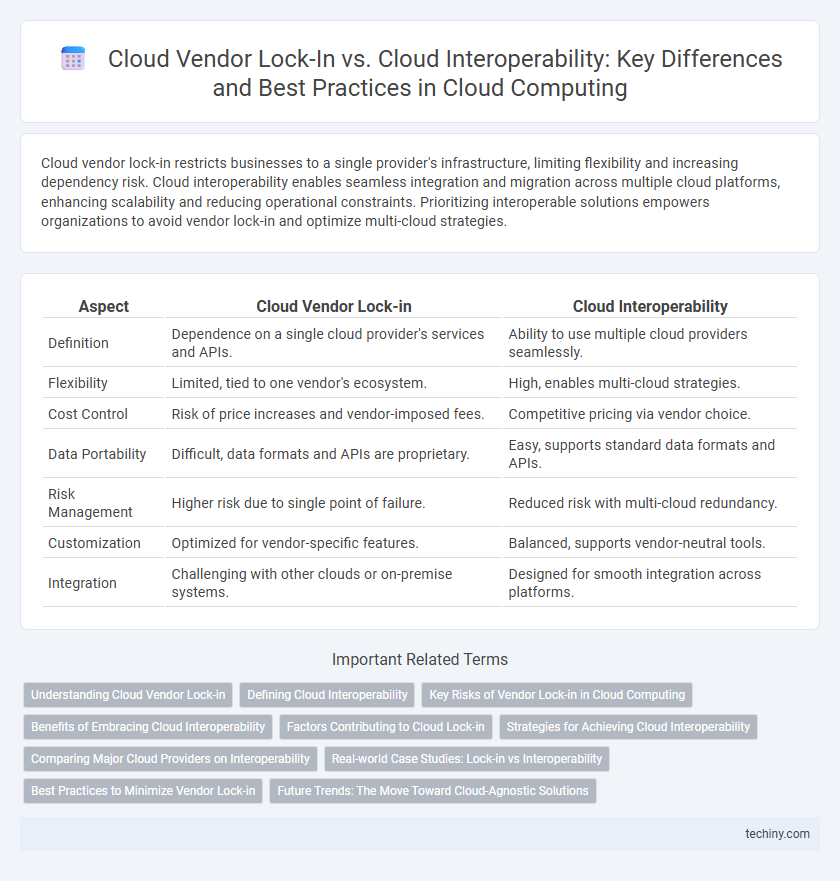Cloud vendor lock-in restricts businesses to a single provider's infrastructure, limiting flexibility and increasing dependency risk. Cloud interoperability enables seamless integration and migration across multiple cloud platforms, enhancing scalability and reducing operational constraints. Prioritizing interoperable solutions empowers organizations to avoid vendor lock-in and optimize multi-cloud strategies.
Table of Comparison
| Aspect | Cloud Vendor Lock-in | Cloud Interoperability |
|---|---|---|
| Definition | Dependence on a single cloud provider's services and APIs. | Ability to use multiple cloud providers seamlessly. |
| Flexibility | Limited, tied to one vendor's ecosystem. | High, enables multi-cloud strategies. |
| Cost Control | Risk of price increases and vendor-imposed fees. | Competitive pricing via vendor choice. |
| Data Portability | Difficult, data formats and APIs are proprietary. | Easy, supports standard data formats and APIs. |
| Risk Management | Higher risk due to single point of failure. | Reduced risk with multi-cloud redundancy. |
| Customization | Optimized for vendor-specific features. | Balanced, supports vendor-neutral tools. |
| Integration | Challenging with other clouds or on-premise systems. | Designed for smooth integration across platforms. |
Understanding Cloud Vendor Lock-in
Cloud vendor lock-in occurs when organizations become dependent on a single cloud provider's proprietary technologies, services, and APIs, making it difficult to migrate workloads or switch providers without significant cost and effort. This dependency limits flexibility and increases risks related to pricing changes, service availability, and innovation constraints. Understanding cloud vendor lock-in is essential for developing strategies that promote cloud portability and interoperability across multiple platforms.
Defining Cloud Interoperability
Cloud interoperability enables seamless integration and communication between diverse cloud services and platforms, allowing businesses to avoid vendor lock-in and optimize flexibility. It encompasses standardized data formats, APIs, and protocols that support workload portability and multi-cloud management. Achieving true interoperability reduces operational risks, fosters innovation, and enhances cost-efficiency in cloud computing environments.
Key Risks of Vendor Lock-in in Cloud Computing
Vendor lock-in in cloud computing poses significant risks such as limited flexibility to switch providers, increased costs due to proprietary service dependencies, and potential data migration challenges that can disrupt business operations. Dependence on a single cloud vendor restricts access to diverse technologies, leading to vulnerabilities if the provider experiences outages, policy changes, or pricing hikes. This inflexibility undermines innovation and scalability, making cloud interoperability a crucial strategy to ensure seamless integration across multiple platforms.
Benefits of Embracing Cloud Interoperability
Embracing cloud interoperability enables seamless integration across multiple cloud platforms, enhancing flexibility and reducing dependency on a single vendor. This approach safeguards against cloud vendor lock-in by facilitating data portability, optimizing workload distribution, and improving disaster recovery strategies. Enterprises benefit from cost efficiency and innovation acceleration through the ability to leverage best-of-breed services from diverse cloud providers.
Factors Contributing to Cloud Lock-in
Proprietary platforms and unique APIs significantly contribute to cloud vendor lock-in by limiting the portability of applications and data across different cloud environments. Lack of standardized data formats and integration protocols further restrict seamless migration and interoperability between cloud providers. Additionally, specialized services and deeply integrated tools offered by specific vendors increase dependencies, making it challenging for organizations to switch providers without substantial reconfiguration and cost.
Strategies for Achieving Cloud Interoperability
Strategies for achieving cloud interoperability involve leveraging open standards and APIs that enable seamless integration between multiple cloud platforms. Employing containerization technologies, such as Kubernetes, facilitates workload portability and consistent application deployment. Adopting a multi-cloud or hybrid cloud architecture mitigates cloud vendor lock-in risks by enabling flexible resource allocation across diverse cloud environments.
Comparing Major Cloud Providers on Interoperability
Major cloud providers like Amazon Web Services (AWS), Microsoft Azure, and Google Cloud Platform (GCP) offer varying degrees of interoperability, with Azure supporting hybrid cloud solutions through Azure Arc and AWS promoting multi-cloud architectures via AWS Outposts. GCP emphasizes open-source tools and Kubernetes for container orchestration, enhancing workload portability across clouds. Evaluating cloud vendor lock-in risks requires analyzing service compatibility, API standards, and data migration capabilities among these providers.
Real-world Case Studies: Lock-in vs Interoperability
Real-world case studies reveal that cloud vendor lock-in restricts flexibility, demonstrated by Netflix's initial dependence on AWS before adopting a multi-cloud strategy to enhance scalability and resilience. In contrast, enterprises like Spotify leverage cloud interoperability to seamlessly integrate services across Google Cloud and AWS, optimizing cost-efficiency and avoiding dependency risks. These examples emphasize the strategic advantage of designing cloud architectures that prioritize interoperability to mitigate vendor lock-in challenges.
Best Practices to Minimize Vendor Lock-in
Adopting containerization and microservices architecture enhances cloud interoperability by enabling applications to run seamlessly across multiple cloud platforms. Employing open standards and APIs reduces reliance on proprietary services, facilitating easier migration and integration. Regularly implementing data portability strategies and leveraging multi-cloud management tools are essential best practices to minimize cloud vendor lock-in risks.
Future Trends: The Move Toward Cloud-Agnostic Solutions
Emerging future trends in cloud computing emphasize the shift towards cloud-agnostic solutions designed to minimize cloud vendor lock-in, enabling organizations to seamlessly deploy and manage applications across multiple cloud platforms like AWS, Azure, and Google Cloud. Technologies such as Kubernetes, multi-cloud management tools, and open-source platforms are driving interoperability by standardizing APIs and containerization, allowing greater flexibility and avoiding dependency on any single provider. This movement supports innovation and resilience by fostering a competitive, flexible cloud environment that adapts to evolving business needs and reduces migration costs.
Cloud Vendor Lock-in vs Cloud Interoperability Infographic

 techiny.com
techiny.com